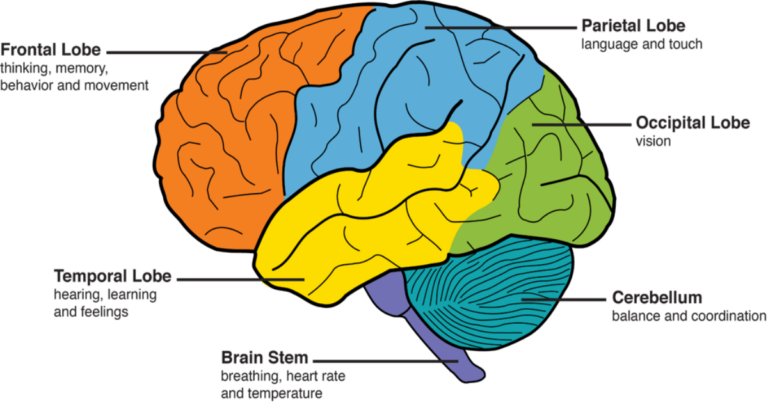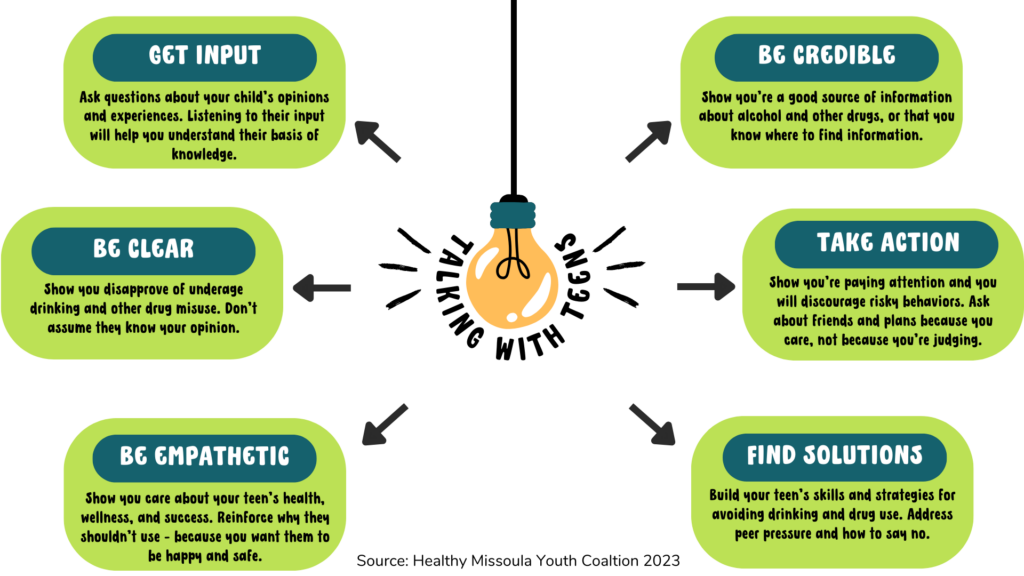As a parent you are the #1 influence on your child’s life, and the conversations you have with your kids now will impact their decisions throughout their whole future.
- Start having conversations with your child(ren) about health choices at a young age (the recommendation is to start before age 8).
These could include conversations about healthy eating or exercise habits, safe decision-making, how to deal with peer pressure, how to find or identify credible health information, healthy coping skills and emotional regulation, as well as discussion of topics like substance use, suicide, or other risky behaviors. The more frequently you have these conversations, and the more you normalize an open pathway of communication regarding serious topics, the easier it will be for your child(ren) to come to you for help in their teen years. - Emphasize the importance of health choices in everyday situations and call attention to prevention events like Red Ribbon Week or Teen Driving Awareness Month in January.
Continuous conversations will resonate more with youth and are more likely to be remembered down the line. Something as simple as pausing a TV show when a character is using substances to briefly discuss it with your child, or talking after you hear an ad on the radio will work. There are many opportunities to renew the conversations with your child(ren). Check out the Healthy Missoula Youth Coalition’s Wellness Awareness Calendar for ideas on when to hold these conversations, like during National Drug and Alcohol Facts Week. - Set a precedent for your family by talking about what your family rules are (ex: curfew, no drinking and driving), and do your best to lead by example.
Youth are more likely to follow a rule if they see that the adults around them are doing the same. For example, if you set a rule for your kids that they cannot use cannabis underage, but you yourself use cannabis, this may send a mixed message. Try to avoid situations where your child(ren) may see you using the substance, or if it is unavoidable, practice harm reduction strategies that follow other expectations, such as not driving after use or quantity control.
- As a parent or caregiver, you can use the ParentingMontana.org rack cards “Marijuana & the Teenage Brain,” “Marijuana: What Does the Law Say?” and “Why Teens Shouldn’t Use Marijuana” to start talking through information with your child(ren). ParentingMontana.org is a resource for parents/caregivers that has been created and vetted by MSU’s Center for Health and Safety Culture.
- Visit SAMHSA’s Parent & Caregiver Resource. Utilize their fact sheets and brochures to walk through information about substance use with your child(ren) as a good starting point, or download the “Talk. They Hear You” app on your phone for additional information and support on the go.
- Nemour’s Kids Health pages give lots of information about different substances youth may be exposed to. Learn about the effects of these substances, and how to discuss them with your child(ren).
- The National Institute on Drug Abuse has a section for parents and caregivers that will provide education on substances and the science of addiction and hosts examples of conversation starters as well. The “Mind Matters” series takes a deeper look into how the brain responds to different drugs and provides age-appropriate resources for those in grades K-9.
Conversation Prompts
Remember: kids asking questions does not always result in them using cannabis. It’s normal for kids to feel curious and have questions.
Asking permission like this will open the line of communication, and makes your teen feel empowered within the dialogue. Be prepared for a possible response of “NO, I don’t want to talk.” If this happens, ask why & have them recommend a time when they would be willing to talk.
Phrasing things in terms of legality also reinforces the idea that it is only legal for adults, not adolescents, and that you aren’t accusing them of anything – you are trying to prepare them with information for entering their adult life.
Asking your teen open ended questions like this helps keep the conversation going, and makes them think about other things that are legal but not necessarily healthy/safe. Alcohol and tobacco are great examples of regulated substances that have severely harmful side effects – such as health problems, DUIs, etc.
Starting the conversation with external perceptions of cannabis may be an easy way of breaking the ice. You could also ask about a news article, tv show, celebrity, or advertisement. It may be easier for your teen to open up about someone else than about their own opinions.
Repeating what you’ve heard your teen say before is a way to show you’ve been paying attention and using reflective listening skills. Asking about what would make it a big deal is a prompt that gets your teen thinking about their future and what may be important to them. Their answer will indicate what their boundaries are around drug use, and will give you insight as to what they know about the health risks of cannabis use already.
Avoid using phrases like “good/bad” or “disapprove” – this can cast shame and alienate your child from the conversation. Instead, frame things in relation to health: “healthy/unhealthy” or that you are “concerned/worried” about their actions rather than disapproving.
Prepare your child in advance by discussing healthy coping skills and activities that can be relaxing. Let them know that you are there in support of them, and will be available if they ever need to talk things through. They won’t get in trouble for asking questions!
If your child is already using cannabis, express your concern for their wellbeing. You could ask “What is going on in your life that makes you feel like you want/need to do this?” Talk through these issues with your child, and offer to work together to find better resources for coping – like yoga, reading, or sports.
If your child had admitted to experimenting with use before, you could ask how frequently they are using cannabis. Even though as a parent you may want them to not use at all, it is important to point out the positive — that it hasn’t become a daily habit. This allows the teen to feel like they aren’t a bad person or a disappointment and opens the door to further conversation about harm reduction practices or other coping skills.
Instead of telling them what to do when they are put in an uncomfortable situation, ask them what they might say. Brainstorming with your teen will be more effective than telling them what to do, because their ideas may mesh better with situations they have found themselves in.
Be truthful about the situation you were in. You may want to point out some of the negative effects this had, like impaired judgment. You should also point out that the cannabis you used in the past was WAY different from the stuff being produced today – today’s THC is much more potent. Explain that you want your child(ren) to be healthy, and with all the new research on how cannabis use affects the developing brain you don’t want your child(ren) to use.
What areas of the brain are impacted by cannabis use?

Frontal Lobe: This part of the brain is typically responsible for critical thinking skills, personality, and decision-making. However, when influenced by cannabis, this part of the brain isn’t able to process information fully – which results in more impulsive behaviors, impaired memory, and a harder time problem-solving.
Temporal Lobe: The temporal lobe is in charge of things like hearing, learning, and feelings. When this part of the brain is affected by cannabis it can result in mood swings, more extreme emotions like increased anxiety or depression (a result of the impact on the amygdala), and decreased memory recall skills.
Brain Stem: Because the brain stem is in charge of regulating heart rate, cannabis can increase your heart rate abnormally and, with repeated use, cause heart disease. Cannabis can increase your heart rate up to 20-30%, and those effects can last up to 3-4 hours after the substance leaves your system. Your heart has to work harder to get good blood circulation, and eventually this can lead to things like heart attack.
Cerebellum: The Cerebellum is in charge of balance and coordination. An easy way of explaining how substance use can affect this part of the brain is to look at how law enforcement conducts DUI tests (and YES, in Montana you can get a DUI for driving under the influence of cannabis). Some tests include walking in a straight line and standing on one foot without wobbling, both of which measure balance and coordination. Cannabis use can decrease a person’s ability to do these skills.
Occipital Lobe: The Occipital lobe is in charge of how your brain processes vision. Because your brain is so overwhelmed with information while under the influence of cannabis, it tries to prioritize what is immediately in front of you rather than your full surroundings – as a result your peripheral vision is diminished (aka tunnel vision) and depth-perception may be altered. This is also why during a DUI stop the officers may do an eye test to see how well you can follow their finger when it moves around (they are looking for smooth movement vs “fidgety/shaky” eyes).
Parietal Lobe: Under the influence of cannabis the body’s pain receptors aren’t as effective, leading to a lesser pain response, and language processing is more challenging. For example: slurred words, incomplete sentences, misinterpreting the meaning of words or using the wrong word by accident.
“Approximately 1 in every 100 people who uses highly potent marijuana will manifest psychotic symptoms”
– American Addiction Center


